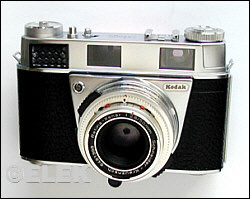Retina IIIS

|
|
|
| Style, film format | Nonfolding interchangeable-lens 35mm rangefinder system with coupled selenium meter |
|
|
|
| Lens, shutter | Coated 50mm f/2.8 Schneider-Kreuznach Retina-Xenar or f/1.9 Retina-Xenon, Synchro-Compur |
|
|
|
| Photo quality | Very good to excellent |
|
|
|
| Ergonomics | Excellent to use although aperture wheel under the lens is a bit odd. |
|
|
|
At the same time that Kodak released its last series of folding Retinas, the so-called Big B and C models, it also unveiled the Retina IIIS, a radical departure from the line.
Unlike previous Retinas, the IIIS was no longer a folding camera. However, it had an integrated meter that didn't rely on the Exposure Value (EV) system, truly interchangeable lenses that it shared with the new Retina Reflex S (and later the III and IV) and framelines that changed according to the lens that was mounted.
The new cameras were wider and heavier and technically superior. However, I think Kodak lost some of the market, because the loyal user base had grown accustomed to the folding Retinas for the past quarter century.
In use, this camera is easy to use. Swapping the three-lobed bayonet-mount lenses is effortless. Setting exposure is a bit tricky, because it involves rotating either the shutter speed ring that surrounds the lens mount or changing the aperture by rotating a serrated wheel under the lens.
And if you ever break the cord that connects the entire mechanism, be prepared for a major, major headache in getting it replaced and restrung.
When functioning correctly, you'll be impressed with its smooth operation and excellent fit and finish. This is an excellent camera, and I have no problems recommending it as an everyday shooter.
